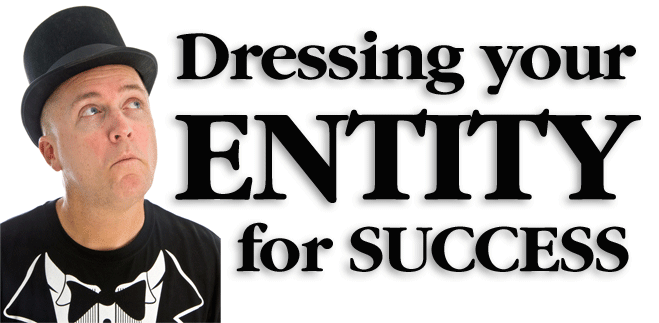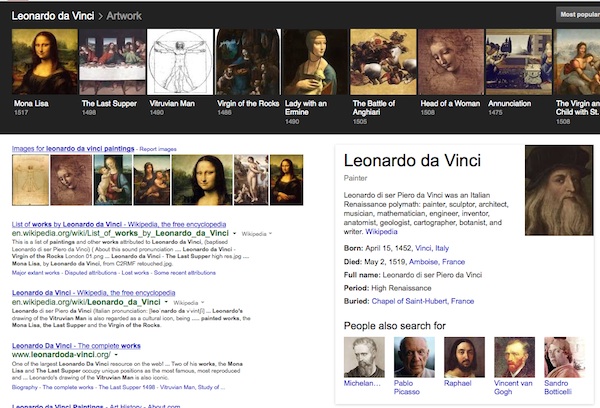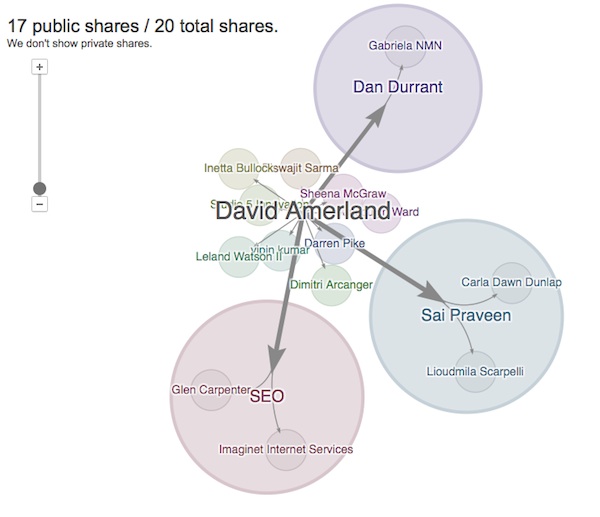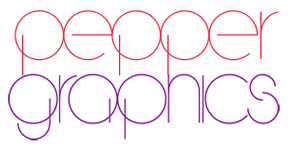Dressing Your ENTITY for Success

“You may send a wrong signal. You may, for instance, turn up at a white-tie function wearing shorts and a t-shirt”, says David Amerland, as he provides an analogy to establishing trust online in his module 5 video lesson about “Google Semantic Search”* from “Plus Your Business.”* If you do this, he suggests, you will need to work harder to establish trust now that you sent out the wrong signals.
When you want to build up your brand or your business online, you may indeed find yourself accidentally walking into the room dressed inappropriately for the event. In other words, showing up to post something that is so out of your professional character that you blow potential colleagues or clients away. I'm sure I have done this. Most people probably have. But as we build our professional credit up here, we need to begin being more conscious of the way we present ourselves as professionals. It is not just a social journey if you want to build a business, yet it is essential to be real, to be transparent, to be ourselves. How do we negotiate the system correctly?
In his book, Google Semantic Search, David Amerland devotes a chapter to the specific ways our identities online are measured by the search engine. Knowing this can help us accidentally avoid the cliff of embarrassment and brand-destroying stupidity.
We are choosing to go online to communicate. There we trust our reputation to a machine. That sounds scary indeed. Who has the right to judge us? But when we have chosen to be there in front of people, we have given them that right. We need to understand the implications of our actions online. How are we being measured? There are 4 Graphs the search engine builds about each of us.
The Social Graph
Your entity (person, company, or brand) has social interactions. These are direct links between your entity and every other entity you connect with. There is a cache of data that shows direct links, personal connections, shared group activities, mentions, and shared content. You are social online and this is all graphed, tracked, to the extent Google can see the content; this is different in each of the social media platforms.
Imagine this offline as a walking diary of your day and all your offline communications with everyone you touch in your world, some by phone, some in person, some at home, some at work. Then realize that a computer algorithm is tallying these results for you.
The Knowledge Graph
When you go to a page on search, in the right column you may see a box with a lot of information about the person, place or thing you are searching. All the knowledge available about this entity online can be included. Your "works," imagine all the works of art of an artist catalogued in one picture database. The knowledge carousel at the top of the Google search page will portray this for an entity it considers famous enough. Your biography is added, then included also are all the serendipitous discovery links generated by people's related search queries. Depending on the topic, "In-Depth" articles researched and written by authorities on the subject may also be featured on the page. Shown below is the search page for Leonardo da Vinci's paintings.

The Link Graph
So familiar to people in the search engine optimization profession, the links to a website were the predominant preoccupation of those who wish to promote a business online. This graph measures which entities link to your entity and who else links to their entities. It identifies the value placed on each of these links, primarily from the list of others who link to them. The links have been easily gamed in the search engine optimization industry. It was a system that could be gamed easily just by posting more links than the next competitor on the page.
It is no longer the valued measure it once was. Google has revised its importance as it is no longer a pure and accurate judgment because of the gaming. However, do not stop trying to connect with, link to and receive real links from others as long as they are sincere votes of trust. Real links from highly respected entities are important to you.
The Engagement Graph
Newest of the graphs, this has developed since the emergence of Google+. The engagement graph charts the level of engagement between entities. Comments on your web posts and articles would be included here, as they go beyond the level of simple social interaction and suggest a continuing conversation and sharing. Plus one's and likes may be included here if they too are part of continuing conversations.
Beyond a +1, you might comment on a post, on a website article, and even share that article with others. In this case you become a sharer or an engager. This is different than a mere social touch. If you link to another entity but you have no mention of this entity elsewhere in your online presence, then you might just be in their social graph. If your engagement with that entity includes other types of interaction such as engagement, conversations, sharing and re-sharing of content from the entity, then you may be in their engagement graph. The search engine measures and tracks those who connect with you in this manner. It is these relationships that can help you or your brand develop real trust online.
Here is a view of the ripples from one of many posts by David Amerland on Google+. It shows you who the engagers and sharers are. These are people who would be added to the engagement graph for the author after sharing this post.

Remember to Put On Appropriate Clothing
Each time you walk out of your house, whether or not it is of concern to you, how you dress seems to be of concern to others. For some voices, it may not be important. For some it can destroy your business. For some you are making a deliberate statement, representing your brand, and representing innovation your way.
This is what you are doing online each time you speak or poke that plus icon. Exercise the control you do have and the choices you make so that the algorithm judging you will make more accurate assumptions of your value. You know, now, what it is judging.
Here are some steps to take to organize this processes for yourself or your business.
Trust Rank Preparation Checklist
1. Which digital platforms are most likely to help promote you as an entity online? Which are most likely to help promote your business?
For each one, plan the topics you will engage on. Learn who are the influencers on these topics on the platforms you wish to use.
2. How will you involve or link to company staff online?
On which platforms are your staff? On which platforms are various business associates, colleagues or customers? How do you wish your company to be represented there by your staff members? Make a blueprint.
3. How is your content platform specific? How will it serve your brand?
Which content is to be shared on which platforms? Decide which people, which topics, and which platforms should be the foci of your company attention. Manage this organization.
4. With different platforms, how will you ensure continuity of tone?
Organize who, what and where to speak with the same message. Align the messages chosen. Be aware that trust for your company will be based on these online actions.
5. What data do you think represents you or your company in each of the Google Graphs?
What is the current state of your knowledge or engagement graphs? How will you guide these in a preferred direction or level of quality? Are there new posting patterns you need to establish to progress toward greater trust? How can Authorship be used to assist your company?
For even more clarity on the details about engagement with others on the social media platforms, you may find this post by David Amerland quite helpful: http://davidamerland.com/seo-tips/931-semantic-search-and-google-plus.html
Please read the other articles in this series, based on this book:
You Are an Entity Not a Keyword
What on Earth is a Knowledge Graph
Passion and Customer Relationships Win at SEO
Local Landscaper Semantic Search Success Story
Why Would Google Recommend You?
Are You Actively Building Your Online Reputation?
Build a Business Dream Team on Google+
Find and enjoy these wonderful resources:
A Few Comments Were Shared on Google+ of Special Clarity
Lena Sinclair wrote:
1) What's the true value of Social graph if the most important information about your connections comes from Engagement graph?
2) At which point among those graphs does authenticity rolls in (sadly, it became such a misused word!)? Does being dressed up really represents you?
David Amerland answered:
The social graph is needed because engagement is just one metric and as such it can be gamed. (I can pay 200 pals to comment and +1 my posts so my engagement looks good) but if they are the only 200 people who so actively engage with me and they are platform specific something's fishy. If I think I am even smarter and also pay them some more to engage with me on Twitter and Facebook and they are the only 200 people who engage with me on each platform, something's fishy again. So by having both breadth (i.e. social footprint) and depth (engagement) in the social signal, it becomes harder to game.
Authenticity then, as you can imagine, comes in through the natural signature of your overall engagement and social activity across the web, over time. (And yep, it is as hard to fake long term as it sounds).
The Knowledge Graph is made up only of knowledge: the things we consider to be qualities or attributes of an entity (like wood burns, it also floats) plus entities (Cedar, Oak, etc).
Lena Sinclair responded:
Crystal clear on social vs. engagement. Funny thing about authenticity though. Since you cannot fake it over a long period of time, it has to be based on passion. Passion towards your brand/business/activity. You cannot be in it for the money alone. Following this trail of logic then it appears that Internet is becoming an educational tool that helps (or forces) us to re-connect with who we really are.
Thank you both, David and Lena, for your conversation that has aided clarification so much. I do not have comments set up on this website, however I will post something that really clairifies the content in my opinion, as I think it should be available to all.

